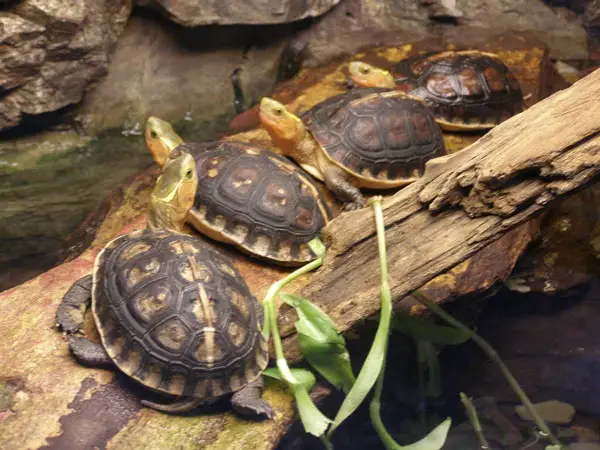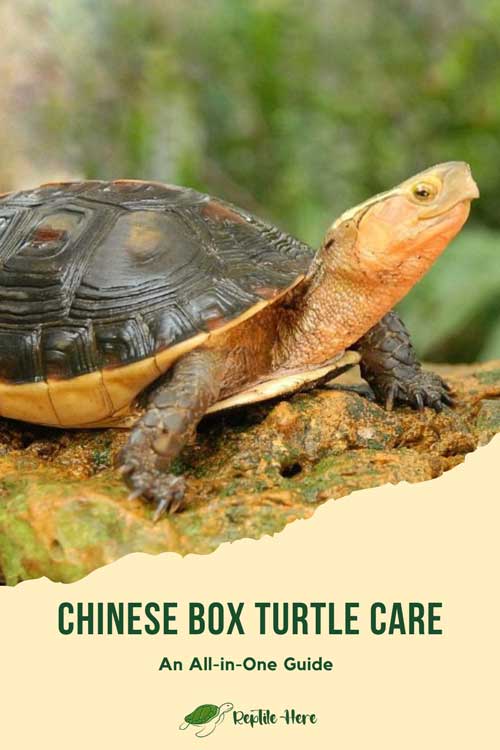Chinese Box Turtle Care: An All-in-One Guide
Otherwise known as Yellow Margined box turtles and Golden-headed box turtles, the Chinese box turtles are one of the highly sought-after breeds among professional keepers. But getting one of these rare turtles is one thing and knowing how to take care of them is another.
Not to mention, if you are looking to keep Chinese box turtles as pets, you need to pay a hefty amount of money to acquire them in the first place. And making such an investment just to offer them a sub-par living condition is not right.
But the real question is, is it hard to take care of Chinese box turtles? Not really! You just need to know the correct care instructions. So, which care process is proper for these reptiles? Well, to know that, you need to keep on reading!
Basic Info About Chinese Box Turtle
Contents
Before getting deep into the Chinese box turtle care process, let’s go through a short Chinese box turtle care sheet:

| Scientific Name | Cuora flavomarginata |
| Common Name | Snake-eating turtle |
| Adult Size | Shell size of 5 to 12 inches long |
| Max Size | A full grown Chinese box turtle can be 12 inches long |
| Lifespan | Around 25 to 40 years |
| Diet | Earthworms, snails, slugs, frozen pinkies, and mealworms |
| Range | Native to southern China and Taiwan |
| Behavior | Voracious |
| Clutch Size | One to three eggs |
| Legal to Keep in USA | Domestically bred box turtles are legal; wild ones are not |
| Extinction Status | Endangered |
Are Chinese Box Turtles Easy to Take Care Of?
The Cuora flavomarginata is easy to take care of. However, note that a Chinese box turtle needs favorable conditions to thrive and be in healthy shape for a prolonged time. And if you do not know which condition is good and which is not, taking care of the Cuora flavomarginata can become challenging.

How to Take Care of a Chinese Box Turtle
There is really no need to go through a strenuous caring process if you want to keep your Chinese box turtle in good shape. You just need to keep these in your mind:
1. Keep the turtle inside an appropriately-sized enclosure
For Chinese box turtles, the large the enclosure is, the better. However, that does not mean that you must keep the turtles in a large-sized housing throughout their lifetime. To illustrate, you can make small juveniles and hatchings stay in a 20-gallon aquarium worry-free.

But do consider the fact that the turtle will outgrow the environment and will try to walk through the glass walls most of the time. On the other hand, for adults, you will need at least a 40-gallon aquarium.
With such a large enclosure, the turtle will get the right amount of space for exercise. Additionally, the large area will offer the right level of air circulation, which is vital for turtles.
2. Always monitor the temperature
Experts and biologists suggest that the ideal enclosure temperature of box turtles should be between 80 degrees Fahrenheit (26.6 C) and 85 degrees Fahrenheit (~30 C). However, the basking site should have a temperature range of 86 degrees (30 C) and 95 degrees Fahrenheit (35 C).
That said, the room temperature of the housing carrying the hatchings should have a temperature of 77 degrees Fahrenheit (25 C) during the daytime. If you find it hard to control extremely low temperatures, consider investing in good heat pipes, heat tapes, and heat cables.
However, you should closely monitor those heating accessories all the time. Otherwise, the turtle might end up with burns.
3. Take notes of the humidity levels
The Chinese box turtles will have great health conditions when humidity is between 60 percent and 80 percent. If you struggle to make the humidity level stay around 70 percent, consider using a dig box. That will help the turtles to regulate and maintain their own requirements.
4. Do not make your turtles develop calcium deficiency issues
Like any other reptile, Chinese box turtles require exposure to UVB lighting. So, consider getting a proper 5.0 UVB bulb for your turtle. These types of lights basically stimulate the effects of the light that the sun provides us with. And thanks to that, you will not need to worry about calcium deficiency issues.
However, at night, you should turn the light off. You should not put a black, red, or blue light near the turtle at night. Why? Box turtles can see colors and have the capability to see infrared light.
5. Use the right substrate
Indoor/outdoor carpet or reptile carpet that comes with timothy hay on the top is the best substrate for box turtles. But what makes this hay so good? Well, it offers the right level of foraging, enrichment, and the extra toe exercise that Yellow Margined box turtles need.

But what should you do when you do not have a carpet with timothy hay? Well, as an alternative, you can use a paper towel, newsprint/newspaper, alfalfa pellets, and butcher paper.
6. Consider the Diet
In case you did not know this yet, box turtles are omnivores. However, they have a tendency to lean more toward the insectivorous and carnivorous side of the spectrum. So, what should be the right diet consist of?
A stable diet will have the following criteria:
- 10 percent fruit
- 40 percent leafy greens and vegetables
- 50 percent high protein or animal protein foods
For animal protein, you can opt for earthworms. Alternatively, you can feed the turtles, slugs, snails, crickets, roaches, and mealworms. They will not fail to enrich the turtle with the right level of protein.
Regarding vegetables, you need to focus on beta-carotene-rich foods and rich greens. However, avoid including kale, spinach, and broccoli too much in meals. These are known to cause urinary and gastrointestinal issues.
You can also include supplements in the meals. For example, calcium supplements added to the food two or three times a week should give the turtles the right boost. On the other hand, for multivitamin supplements, once a week is more than enough. Also, feed the juveniles daily, while adults should be fed every other day.
Can You Keep Chinese Box Turtles as a Pet?
Chinese box turtles will make for great pets as long as you know how to take care of them. Unlike tortoises, box turtles do not gain a large shape. Therefore, you will not need to worry about not having the right amount of space.

What Does a Chinese Box Turtle Need in a Tank?
The tank should have an aquatic setup. It should have half land and half water. And the land part of the tank should have a proper basking area that meets the right temperature criterion.

Can You Feed Chinese Box Turtles Cat or Dog Food?
You should not feed the Chinese box turtles cat or dog food. Those cans of food usually have a high protein level. An excessive level of protein can cause kidney issues to come up for turtles. So, do not feed the boxies dog or cat food. Instead, rely on a balanced protein source.
Final Words
See? It is not really that hard to learn how to take proper care of Chinese box turtles. You just have to make sure you are maintaining the right enclosure environment and feeding them properly. Also, do not forget to change the aquarium if you have purchased a small one while getting a juvenile Chinese box turtle.


